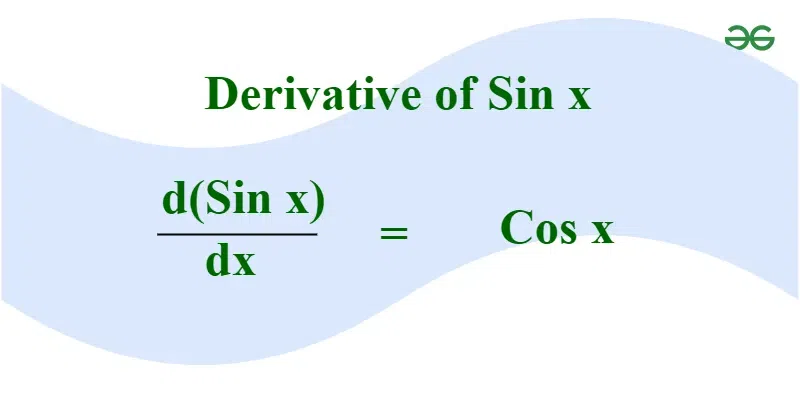
|
|
Derivative of Sin x is Cos x. It refers to the process of finding the change in the sine function with respect to the independent variable. This process is known as differentiation, which is one of the fundamental tools in calculus used to determine the rate of change for various functions. The specific process of finding the derivative for trigonometric functions is referred to as trigonometric differentiation, and the derivative of Sin x is one of the key results in trigonometric differentiation. 
In this article, we will learn about the derivative of sin x and its formula including the proof of the formula using the first principle of derivatives, quotient rule, and chain rule as well. Other than that, we have also provided some solved examples for better understanding and answered some FAQs on derivatives of sin x as well. Let’s start our learning on the topic Derivative of Sin x. Table of Content What is Derivative in Math?The derivative of a function is the rate of change of the function with respect to any independent variable. The derivative of a function f(x) is denoted as f'(x) or (d /dx)[f(x)]. The differentiation of a trigonometric function is called as derivative of the trigonometric function or trig derivatives. Read More: What is Derivative of Sin x?Among the trig derivatives, the derivative of the sinx is one of the derivatives. The derivative of the sin x is cos x. The derivative of sin x is the rate of change with respect to angle i.e., x. The resultant of the derivative of sin x is cos x. Derivative of Sin x FormulaThe formula for the derivative of sin x is given by:
Proof of Derivative of Sin xThe derivative of sin x can be proved using the following ways:
Derivative of Sin x by First Principle of DerivativeTo prove derivative of sin x using First Principle of Derivative, we will use basic limits and trigonometric formulas which are listed below:
Let’s start the proof for the derivative of sin x
Derivative of Sin x by Quotient RuleTo prove derivative of sin x using Quotient rule, we will use basic derivatives and trigonometric formulas which are listed below:
Let’s start the proof of the derivative of sin x
Derivative of Sin x by Chain RuleTo prove derivative of sin x using chain rule, we will use basic derivatives and trigonometric formulas which are listed below:
Let’s start the proof of the derivative of sin x
Also, Check
Examples on Derivative of Sin xExample 1: Find the derivative of sin 4x. Solution:
Example 2: Evaluate the derivative f(x) = (x3 + 5x2 + 2x + 7)sinx Solution:
Example 3: Find the derivative of p(x) = (4x2 + 9)/sinx Solution:
Example 4: Find the derivative of the function (cosx)sinx Solution:
Example 5: Evaluate the derivative sin 5x + x.sinx Solution:
Example 6: Find derivative of sin-1 x. Solution:
Example 7: Find derivative of sin x2 Solution:
Example 8: Find derivative of sin x. cos x Solution:
Example 9: Find derivative of x sin x Solution:
Example 10: What is derivative of sin x and cos x Solution:
Practice Questions on Derivative of Sin xQ1. Find the derivative of sin 7x Q2. Find the derivative of x2.sinx Q3. Evaluate: (d/dx) [sin x/(x2 + 2)] Q4. Evaluate the derivative of: sin x. tan x Q5. Find: (tan x)sin x ConclusionThe derivative of the sine function, sin(x), is the cosine function, cos(x). Mathematically, if f(x)=sin(x), then f′(x)=cos(x). This result comes from the limit definition of the derivative and the fundamental properties of trigonometric functions. The derivative of sin(x) is cos(x).The relationship is pivotal in calculus, especially in solving problems involving periodic motion, wave analysis, and oscillations. The fact that the derivative of sin(x) is cos(x) also reflects the intrinsic connection between these two functions, as they are phase-shifted versions of each other.Derivative of sin(x) tells you something about the rate of change of the sine function at any given point. If sine is a wave, cosine tells you whether the wave is rising, falling, or at a peak/trough at any given point. Imagine the sine function as a wave. The derivative, cosine, tells you if the wave is currently going up, down, or is flat (neither going up nor down). Derivative of Sin x – FAQsWhat is Derivative?
Write the Formula for Derivative of Sin x.
What is the Derivative of Sin (-x)?
What are the Different Methods to Prove Derivative of Sin x?
What is the Derivative of Negative Sin x?
What is Derivative of Cos x?
What is the Derivative of 2 sin x?
What is the Derivative of Tan x?
|
Reffered: https://www.geeksforgeeks.org
| Class 11 |
Type: | Geek |
Category: | Coding |
Sub Category: | Tutorial |
Uploaded by: | Admin |
Views: | 13 |